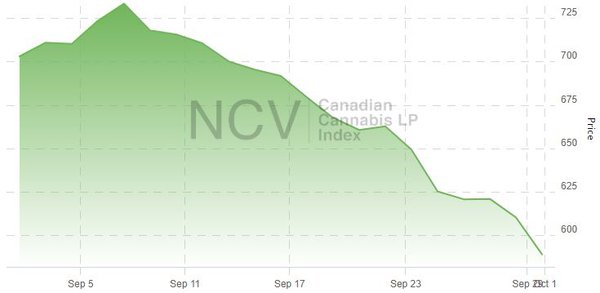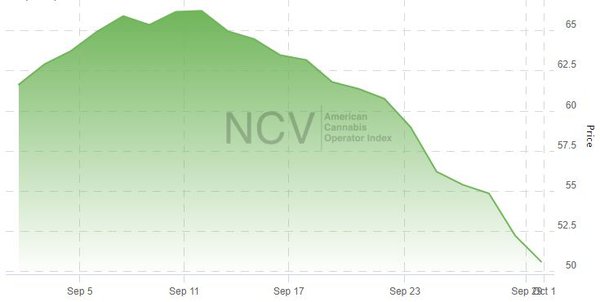North American cannabis collapse continues
Published 18-OCT-2019 15:35 P.M.
|
6 minute read
Hey! Looks like you have stumbled on the section of our website where we have archived articles from our old business model.
In 2019 the original founding team returned to run Next Investors, we changed our business model to only write about stocks we carefully research and are invested in for the long term.
The below articles were written under our previous business model. We have kept these articles online here for your reference.
Our new mission is to build a high performing ASX micro cap investment portfolio and share our research, analysis and investment strategy with our readers.
Click Here to View Latest Articles
Cannabis stocks got smashed again in September, with the vaping crisis placing additional downward pressure on sentiment and outlook.
As I sat down to write this post, I reflected on the disclaimer we put under any graphs we post: past performance is not an indicator of future performance. Well, thank f*** for that! September brings to a close the sixth consecutive month of plummeting share prices, market confidence, and investor sentiment.
The Global Cannabis Index declined 16% in September, leaving the index 16.8% down year to date.

The Canadian Cannabis LP Index declined 16.2% in September, leaving the index 16.4% down year to date.

The American Cannabis Operator Index declined 17.9% in September, leaving the index 34.5% down in 2019.

It has been an incredibly tough few months for cannabis stocks. Given the fact that the industry is still so nascent, cannabis stocks are heavily influenced by investor sentiment, and right now institutional investors are seeking to avoid the risk, and retail investors flee the sector to find better opportunities in other short-term growth areas.
This is not a new occurrence for cannabis stocks. There have been many periods in the past where there have been months of continuous price declines. These periods were almost always followed by a green-swan event, which acted as the catalyst that drove a stock rally.
Events like Constellations' first and second investment in Canopy Growth, Altria's investment in Cronos, and major legislative events such as the Canadian elections of 2016 and California's legalisation in January 2018.
Right now there is only Canada's legalisation of edibles and extracts on the horizon that could be a green-swan style event, but the vaping crisis has quickly scuttled that potential.
The Vaping crisis
At the time of writing, there have been over 805 reported cases and 13 deaths across 46 US states. People are arriving at the hospital with symptoms like difficulty breathing, vomiting, stomach pains and fevers, and all as a result of using illicit vape equipment and oils.
To date, there have been no definitive answers as to what is causing this epidemic, but it is being speculated that Vitamin E Acetate – a cutting agent used to thicken cannabis oil for resale purposes in the black market – is behind the spate of illnesses.
In a time when calmness is needed, hysteria is starting to take control. Already, Massachusetts has placed a complete ban on all vaping products until February next year (to give authorities time to figure this out). And just last week, a council member in Los Angeles called for a temporary ban on all cannabis vaping products.
It seems most — if not all — of the hospitalisations were related, not to e-cigarettes, but illicit street vapes. If vaping products are banned or restricted we can expect to see more stories like this as people increasingly turn to the black market.
– Michelle Minton, Competitive Enterprise Institute
The only reason people were using the black market in the first place, is either because the product is not legally available in their state, or if it is, it is simply way too expensive. This is not the time to be making hasty policy decisions that may actually aggravate the situation. Rather, this is the opportunity to better understand how legalisation and quality controls could be the best form of defence.
It's way too early to know what regulators are going to do (or not do), but the impact has already been significantly felt throughout the cannabis industry. Vape sales are down, and public companies heavily exposed to the vaping industry have been heavily oversold.
However, September certainly wasn't all doom and gloom. This is a nascent industry, that continues to grow and develop on a global scale. During the month, two key legislative changes took place in both the Northern and Southern hemispheres.
The SAFE Banking Act
One really positive moment in September was the SAFE Banking Act being passed (by a majority vote of over 70%) in the United States House of Representatives. The first significant piece of cannabis legislation to pass through the House, this represents a very firm step forward for the industry.
Because cannabis is still illegal at the Federal level, it is illegal for financial institutions to do business with companies that touch the plant. The SAFE Banking Act essentially grants "amnesty' to these institutions and governs the way they can engage with these companies. This would finally allow cannabis businesses to deal with the major credit card companies.
The bill will now need to pass through the Senate Banking, Housing and Urban Development sub-committee before a vote in front of the full Senate (potentially by the end of the year).
Australia's capital says yes to legalisation
This month saw Canberra's local government legalise the possession and cultivation of cannabis for adult recreational use. Before you get too excited and book your next vacation there, although it's legal to possess up to 50 grams and grow up to 4 plants (per household), you cannot buy it (or sell it). I know what you're thinking, but still, it's a good first step.
And so to October
Canada Legalisation 1.0 has been pretty amateur in its rollout and execution. With almost no brick-and-mortar retail and a very poor product selection, the numbers coming in over the past 12 months have been extremely underwhelming.
Legalisation 2.0 of edibles and extract, due later this month, was supposed to be the big catalyst that would drive the market, the revenues and the stock prices. However, recent news of the first "vaping victim" in Ontario, has placed serious doubt over whether vaping products will be part of the 2.0 launch or not.
Investor sentiment needs repairing and valuations could remain under pressure in the short term.
On the back of lackluster results, the firing of Bruce Linton, CannTrust's implosion, and with the vaping crisis now looming large in the minds of the regulators, I think it would be fair to say that investor sentiment needs repairing and valuations could remain under pressure in the short term.
The US cannabis stocks have been even harder hit than their northern compatriots. But this is still undoubtedly where we believe the real value lies in the short to medium term. Although there have been delays with the Department of Justice's Anti-Trust division looking into the mega-mergers that took place earlier in the year, everything points to a positive outcome. We expect that once these deals do close, it could reignite interest in the space and start to move the sentiment dial.
After a really solid rally in the first quarter of the year, it has been a bloodbath selloff all the way to the beginning of the final quarter of the year. In 2018, the final quarter of the year was a devastating one, with cannabis stocks losing nearly 40% of their value in a 45 day period.
But then again, past performance is not an indicator of future performance.
Article reprinted with permission of The Green Fund.
General Information Only
This material has been prepared by StocksDigital. StocksDigital is an authorised representative (CAR 000433913) of 62 Consulting Pty Limited (ABN 88 664 809 303) (AFSL 548573).
This material is general advice only and is not an offer for the purchase or sale of any financial product or service. The material is not intended to provide you with personal financial or tax advice and does not take into account your personal objectives, financial situation or needs. Although we believe that the material is correct, no warranty of accuracy, reliability or completeness is given, except for liability under statute which cannot be excluded. Please note that past performance may not be indicative of future performance and that no guarantee of performance, the return of capital or a particular rate of return is given by 62C, StocksDigital, any of their related body corporates or any other person. To the maximum extent possible, 62C, StocksDigital, their related body corporates or any other person do not accept any liability for any statement in this material.
Conflicts of Interest Notice
S3 and its associated entities may hold investments in companies featured in its articles, including through being paid in the securities of the companies we provide commentary on. We disclose the securities held in relation to a particular company that we provide commentary on. Refer to our Disclosure Policy for information on our self-imposed trading blackouts, hold conditions and de-risking (sell conditions) which seek to mitigate against any potential conflicts of interest.
Publication Notice and Disclaimer
The information contained in this article is current as at the publication date. At the time of publishing, the information contained in this article is based on sources which are available in the public domain that we consider to be reliable, and our own analysis of those sources. The views of the author may not reflect the views of the AFSL holder. Any decision by you to purchase securities in the companies featured in this article should be done so after you have sought your own independent professional advice regarding this information and made your own inquiries as to the validity of any information in this article.
Any forward-looking statements contained in this article are not guarantees or predictions of future performance, and involve known and unknown risks, uncertainties and other factors, many of which are beyond our control, and which may cause actual results or performance of companies featured to differ materially from those expressed in the statements contained in this article. S3 cannot and does not give any assurance that the results or performance expressed or implied by any forward-looking statements contained in this article will actually occur and readers are cautioned not to put undue reliance on forward-looking statements.
This article may include references to our past investing performance. Past performance is not a reliable indicator of our future investing performance.
